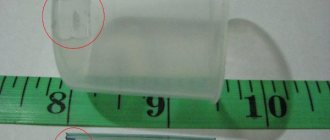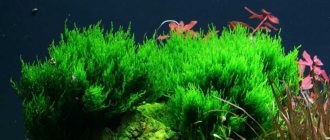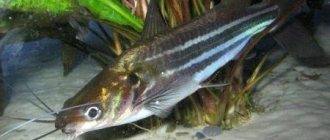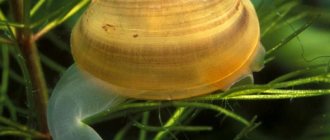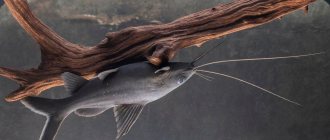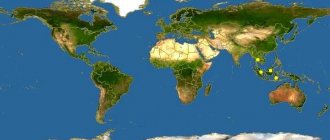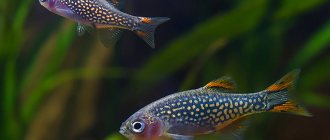Home › Aquarium plants › Catalog of aquarium plants ›
( 4 ratings, average: 3.75 out of 5)
Aquatic buttercup or ranunculus inundatus (Ranunculus inundatus) is a stunningly attractive aquarium plant from Australia with an unusual leaf shape, used in the aquarium as a foreground and middle ground plant.
Ranunculus inundatus or water buttercup (Ranunculus inundatus)
Family: Ranunculaceae
Width: 15 – 15 cm
Growth rate: Average
Content complexity:
Possible lighting:
Temperature: 20 – 29 °C
CO2 supply: 6 – 14 mg/l
Ranunculus inundatus is one of the few aquatic plants native to Australia that is grown in aquariums. This plant differs from all representatives of this species in its small size and beautiful carved leaves in the shape of an umbrella. In this case, each leaf grows on a separate vertical shoot.
Ranunculus inundatus is sometimes called water buttercup. In an aquarium it can be used in the middle or foreground as an accent. It is as a foreground plant that it has gained the greatest popularity. Pairs well with even shorter foreground plants.
The low growth rate is compensated by a large number of side shoots. And under favorable conditions, it can quite quickly fill the entire foreground if not controlled.
This plant does not make serious demands on water parameters. Slightly acidic water with a temperature of 20–29°C is suitable; hardness does not matter. The supply of carbon dioxide helps to stimulate the growth rate.
Moderate to bright lighting greatly affects the height of Ranunculus inundatus. So, in bright light, its height usually does not exceed 5 cm. In medium light, the stems stretch, trying to be higher than the nearest plants. The duration of daylight is more than 12 hours.
Intense lighting is necessary if the plant is used in the foreground. For the middle ground, it is better to use less intense light so that the water buttercup is not hidden behind the foreground design elements.
As a soil, it is recommended to use a moderately silted fine substrate, spread in a layer of at least 3–5 cm. To fill the foreground, the bush is divided into several parts, which are planted at a distance of several centimeters from each other.
If you want to form a separate dense bush in the middle ground, then to do this you need to constantly remove the side shoots, preventing it from growing in breadth.
What are ground cover plants
These plants got their name due to their ability to spread right at the surface of the soil, creating beautiful clearings and mats. The vast majority of such plants are quite whimsical and require compliance with three important conditions:
- aquarium height no more than 60 cm;
- supply of CO2 and fertilizers containing macro- and microelements;
- bright lighting - at least 0.7 Watt/liter (no more than 10 hours a day).
There are no special requirements for the composition of the soil, but it must be shallow so that the root system can grow well and gain a foothold.
The leaves of groundcovers are very delicate - the slightest growth of algae can destroy them, so you need to monitor the microflora very carefully.
The selection of fish when growing ground cover plants also needs to be taken seriously. The aquarium should not contain corydoras, that is, varieties that dig the soil and actively move along it.
Ranunculus inundatus or water buttercup (Ranunculus inundatus)
Under natural conditions, the plant Ranunculus inundatus, or as it is also called, water buttercup, grows in the marshy ponds of Australia. This plant, perhaps, can be attributed to a small part of the representatives of the Australian continent that were able to acclimatize in aquariums and, as a result, spread throughout the world.
Ranunculus inundatus is a very small plant, with very unusual and beautiful carved leaves resembling the shape of a snowflake, growing on individual vertical shoots. The leaf blade is painted bright green, and its color does not depend on the conditions of detention. In aquarium conditions, the height of the bush reaches about 5 cm and the width is 15 cm. The growth rate is average, which is compensated by a fairly large number of side shoots, which, in conditions that satisfy the plant, relatively quickly fill the entire foreground of the aquarium.
It is advisable to plant water buttercup in the foreground or middle ground. Due to its low stature, the plant serves as a ground cover. With the help of this plant, it can be successfully used to decorate the foreground in nanoaquariums. The water buttercup looks very beautiful against the backdrop of even smaller plants in the foreground. To form a single bush of a plant planted in the middle ground, it is necessary to constantly remove all its side shoots and thus prevent it from growing in breadth.
Ranunculus inundatus does not have high requirements for water parameters, which should be as follows: temperature 20-29°C, hardness 2-24°, acidity pH 5.3-7.4. To stimulate growth, a CO2 supply of 7-12 mg/l is required. It is advisable to add microfertilizers to the water.
The soil should be fine sandy or in the form of fine gravel, well silted, with a layer thickness of about 3-5 cm. The plant should be planted by removing the side branches from it, then the plant will look more decorative. If you plant ranunculus with side shoots, then over time a very dense green carpet will form and will need to be thinned out periodically.
Description and origin
Aquatic buttercup is a creeping aquarium plant that lives in nature in Australia, its south-eastern part. In nature it grows in muddy soil, ponds and rivers.
It appeared in the aquarium hobby only a few years ago. Buttercups grow in swamps all over the world, but Ranunculus inundatus is one of the few species of Ranunculus that can grow completely submerged in water. The amazing shape of the buttercup leaf has made it incredibly popular in the aquarium hobby. Unlike many plants that change leaf color depending on conditions, the leaves of Ranunculus inundatus always remain light green. This property is very useful if you need to create contrast in an aquarium.
The rhizome of the water buttercup is a central creeping stem from which new leaves emerge. The rhizome grows along the ground - typical growth of ground cover plants. Each shoot from the rhizome has one star-shaped leaf developing on the stem. Leaves with a stem can reach 5-12 cm in height depending on the lighting. May bloom with small yellow flowers.
Reproduction
The water buttercup reproduces in several ways. The first method is by seed, after the plant blooms with yellow flowers, seeds are formed from them. But this is only possible if ranuncusus grows in the air. It is also able to reproduce using cuttings that grow from the rhizome. After the new shoots are strong enough and leaves appear on them, they can be separated from the mother bush and planted as an independent plant.
Content
Water Buttercup Ranunculus inundatus needs medium to strong light to grow and thrive. Low lighting will lead to stunted plant growth and the appearance of tall leaves with long stems stretching towards the light. If you want to get a thick, compact “carpet” in the aquarium, provide lighting of at least 1 W/liter of water.
The soil should be fine (up to 3 mm) or sand, preferably light nutritious, or with a nutritious backing.
Strong lighting must be supported by nutrients. Liquid fertilizers with macro and micro elements should be regularly applied, and it is also advisable to regularly add CO2.
Water parameters can be in a wide range, both hardness and acidity pH.
Ranunculus inundatus is generally not a demanding plant and can adapt to any conditions. When a water buttercup is first introduced to an aquarium, it may require a significant adaptation period, ranging from several weeks to a month. At this time, little new growth is visible, although the plants remain healthy. After an adaptation period it grows very quickly.
Common Problems with Ground Cover Plants
| Problem | Cause | Solution |
| Plants are weak and fragile, but very elongated | Lack of light | Change the lighting interval - at least 10-12 hours |
| The edges of the leaves turn yellow and curl | Potassium deficiency | Add extra potassium |
| Leaves are yellow or brown, very fragile | Iron deficiency, too hard water | Check water hardness, feed plants with iron |
| Premature leaf drop | Phosphate deficiency | Use fertilizers containing nitrogen, phosphorus, potassium |
| The water turned green and algae appeared | Excess phosphates | Siphon the soil, do a water change, limit the application of fertilizers |
| New leaves become deformed and fall off quickly | Calcium deficiency | Supplement your plants with calcium |
| Brown spots on leaves | Magnesium deficiency | Use magnesium as a supplement |
| Plants are slow to develop, leaves are pale and brittle | Nitrogen deficiency | Replenish nitrogen deficiency |
| The root system is weak, the roots turn black, the plants do not take root and float | Bad soil | The soil should be siphoned and, if necessary, fertilizing should be used. |
Aquascape
When creating an aqua design, the aquatic buttercup can be used for the middle or foreground. Ranunculus inundatus is also an excellent choice for creating an accent or focal point. When used in an aquascape, water buttercup can be compared to marsilia.
If the aquarium has a low level of light, it is better to use Ranunculus inundatus for the middle ground, or plant the aquatic buttercup between the stones so that the stems reaching towards the light are covered. When used as a foreground ground cover, the light should be very high to encourage a shorter leaf shape. And yet, buttercup is rarely used on its own to create a carpet, usually in combination with other plants, creating an excellent contrast.
Often, when Ranunculus inundatus goes through a period of adaptation, its growth becomes rapid, so pruning of runners is required to maintain a compact grouping. This will help keep you fit and keep the group together.
FAQ from George Farmer
Jorja Farmer is a well-known aquascaper who often gives advice to beginners and advanced waterscape enthusiasts.
- Be patient with growing plants, especially groundcovers - some take time to take root and begin to grow.
- Don't forget about maintaining your aquarium or paludarium - this is the most important part of aquascaping.
- Do not skimp on equipment and fertilizers, otherwise all efforts will be in vain.
- It is advisable to use filtration, but in any case do not allow the accumulation of organic matter and waste.
- Do not use excessive amounts of light (enough lighting, but not excessive) and do not change water too often.
- LEDs can be used as lighting devices - they are efficient and reliable.
- When algae appears, find out the cause of the problem, and then begin to fight it.
- You can get rid of algae using Amano shrimp or other algae eaters, as well as a targeted supply of liquid carbon.
Ground cover plants are an excellent decoration for an aquarium or paludarium. With proper care, they will help create unique compositions and landscapes.
